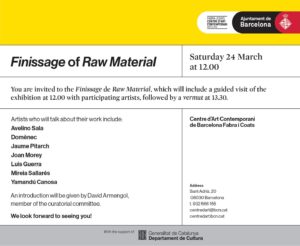
Bajo Radar
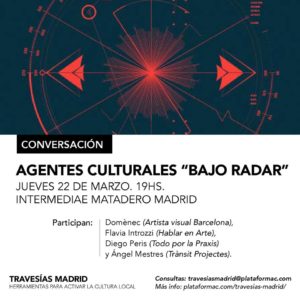
Domènec. Not Here, Not Anywhere. MACBA
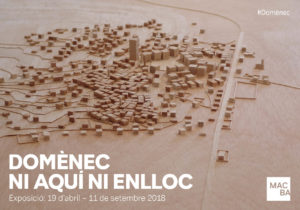
19 Apr. to 11 Sep. 2018
MACBA Museu d’Art Contemporani de Barcelona
Quaderns d’Arquitectura i Urbanisme # 268-269
Sostenere il palazzo dell’utopia at Quaderns d’Arquitectura i Urbanisme # 268-269
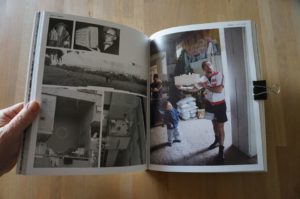
How to Live with Memory. Artistic Attitudes towards Architecture and Francoism
MUSAC, Museo de Arte Contemporáneo de Castilla y León
Avenida de los Reyes Leoneses, 24
24008 León
17 February, 2018 – 3 June, 2018
Artists: Toni Amengual, Sergio Belinchón, David Bestué, Albert Corbí, Juan Cruz, Domènec, Chus Domínguez, María García Ruiz, Alejandro S. Garrido, Iñaki Gracenea, Fran Meana, Rosell Meseguer, Txuspo Poyo, Ignasi Prat, Fernando Sánchez Castillo, Santiago Sierra, Begoña Zubero
Curatorship: Manuel Olveira
Ville-Usine
LE CAP – Centre d’arts plastiques de Saint-Fons (Lyon). 2017
Photo Series (4 photos 45 x 60 cm)
Solo exhibition of Domènec at MACBA
Curator: Teresa Grandas
April – September 2018
MACBA
Plaça dels Àngels, 1
08001 Barcelona
http://www.macba.cat/en/exhibition-domenec/1/exhibitions/expo
This solo exhibition of Domènec (Mataró, 1962) offers a retrospective of his work from the late 1990s to the present, including some new projects. Using certain emblematic buildings or monuments of modernity as referents, Domènec analyses the proposals of the modern movement and its legacy within contemporary practice. Supporting his research are projects in situ, installations, maquettes, photographs, workshops, seminars and videos. Based on various local contexts, his work establishes a dialogue with other international themes to highlight the impact on the present of the utopian ideas that resulted from the Industrial Revolution and as a stand against capitalism.
Under The Shadow Of Participation
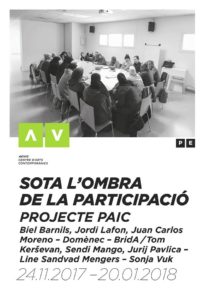
PAIC Project
ACVIC Centre d’Arts Contemporànires, Vic
24.11.2017 – 20.01.2018
Biel Barnils, Jordi Lafon, Juan Carlos Moreno / Domènec / BridA / Line Sandvad / Sonja Vuk
Raw Material
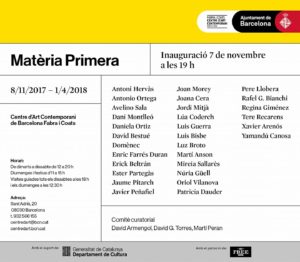
Fabra i Coats. Centre d’Art Contemporani de Barcelona
08 / 11 / 2017 – 01 / 04 / 2018
Curatorial committee: David Armengol, David G. Torres i Martí Peran
Artists: Antoni Hervàs, Antonio Ortega, Avelino Sala, Dani Montlleó, Daniela Ortiz, David Bestué, Domènec, Enric Farrés Duran, Erick Beltrán, Ester Partegàs, Jaume Pitarch, Javier Peñafiel, Joan Morey, Joana Cera, Jordi Mitjà, Lúa Coderch, Luis Guerra, Luis Bisbe, Luz Broto, Martí Anson, Mireia Sallarès, Núria Güell, Oriol Vilanova, Patricia Dauder, Pere Llobera, Rafel G. Bianchi, Regina Giménez, Tere Recarens, Xavier Arenós and Yamandú Canosa.
Conversation Piece: Les Minguettes
LE CAP – Centre d’arts plastiques de Saint-Fons (Lyon), 2017
En Résonance avec la Biennale de Lyon 2017
Installation. 4 models, screen, wood / Video, 3’24” / Wall paper
After the Second World War, cities in Europe and the United States grew rapidly with social housing policies which translated into the construction of large urban complexes of ‘vertical housing’.
The Pruitt-Igoe neighbourhood in St Louis (Missouri), created between 1954 and 1955, was one of the first and principal social housing projects built in a US city. At the end of the sixties it had become a neighbourhood known internationally for its poverty, violence and racial segregation, and for this reason its thirty-three buildings were demolished with explosives in the mid-seventies. The project became an icon of the failure of certain social housing policies, and some theorists described the demolition as ‘the day modern architecture died’.
Conversation Piece: Les Minguettes (2017) is a project centred around the story of Les Minguettes, a large social housing estate in Vénissieux, in the suburbs of the industrial south of Lyon, built in the sixties and partially demolished in the nineties. The neighbourhood houses a large number of immigrants from former French colonies and has been an important part of the history of popular movements in France. It is in precisely this ‘great whole’ that the ‘march for equality and against racism’, better known in France as the Marche des beurs, was born in 1983 and brought almost 100,000 people out onto the streets.
At the end of the seventies, the housing utopias derived from the Athens Charter (published in 1942) are wrecked on metropolitan peripheries after years of being characterised by marginalisation, youth unemployment, a lack of expectation and police brutality. At the beginning of the eighties, violent riots broke out in many neighbourhoods of France’s banlieue and in 1983 this ill-feeling is articulated at Les Minguettes as a political protest movement against the institutional racism which had spread across the country.
These demonstrations force the government to introduce a set of policies of improvement. At the start of the nineties, the government opts for the usual unilateral, skin-deep and spectacular policies and adopts a mopping-up solution, which is to say, knock down some of the neighbourhood’s huge blocks. The first sector to be demolished went by the name of Démocratie (Democracy).
Conversation Piece: Les Minguettes reproduces to scale the buildings of one square in the neighbourhood – popularly known as Red Square – which are converted into a meeting place in which to sit and discuss or watch a video wherein, using manipulated images taken from news broadcasts, the demolition is symbolically reversed.
Video edition: Rafa Ruiz
with the support of Institut Ramon Llull
October 2025
August 2025
April 2025
January 2025
September 2024
March 2024
February 2024
April 2023
February 2023
January 2023
December 2022
November 2022
February 2022
December 2021
July 2021
April 2021
January 2019
December 2018
November 2018
October 2018
September 2018
August 2018
July 2018
June 2018
April 2018
March 2018
February 2018
January 2018
November 2017
October 2017
July 2017
May 2017
April 2017
February 2017
December 2016
November 2016
October 2016
July 2016
June 2016
May 2016
March 2016
November 2015
September 2015
August 2015
July 2015
June 2015
April 2015
March 2015
February 2015
January 2015
December 2014
November 2014
October 2014
September 2014
August 2014
July 2014
June 2014
April 2014
March 2014
February 2014
January 2014
December 2013
November 2013
October 2013
September 2013
August 2013
June 2013
May 2013
April 2013
March 2013
February 2013
January 2013
November 2012
October 2012
September 2012
August 2012
July 2012
June 2012
May 2012
April 2012
March 2012
February 2012
January 2012
December 2011
November 2011
October 2011
September 2011
August 2011
July 2011
June 2011
April 2011
February 2011
January 2011
December 2010
November 2010
October 2010
September 2010
August 2010
July 2010
June 2010
May 2010
April 2010
March 2010
February 2010
January 2010
November 2009
October 2009
September 2009
August 2009
July 2009
June 2009
May 2009
April 2009
March 2009
December 2008
November 2008